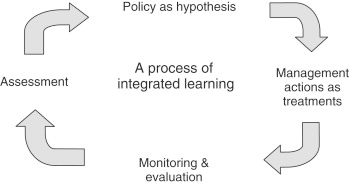The plant communities of our natural areas are complex, dynamic systems. Managing these natural systems to sustain their native biodiversity can benefit from an iterative, learning-based approach known as adaptive management. This process combines land management actions with regular assessments to understand and inform future management in a continual process.
Adaptive management can be viewed as a series of informed experiments to best manage ecological systems. The assessment phase uses existing knowledge and collected information to develop management policies and actions, while knowing that there could be unexpected outcomes. The effectiveness of the management is evaluated through additional monitoring and research. This information can either validate the effectiveness of the management actions, or guide new or modified management actions. Ultimately, the process yields new conservation strategy insights and an improved understanding of the dynamic systems.

Flowchart of adaptive assessment and management.
Adaptive Management at Cornell Botanic Gardens
The recent history of deer management at Cornell Botanic Gardens offers a good example of the adaptive management approach.
Based on decades of deer impacts on local biodiversity, agricultural damage, and deer-vehicle collisions, Cornell University implemented a suburban deer research and management program in 2007. Cornell’s Integrated Deer Research and Management (IDRM) program aimed to reduce deer numbers and associated impacts through use of surgical sterilization on the core campus, and a hunting program on surrounding lands. We chose to complement these approaches with assessments of deer abundance, monitoring of deer behavior, evaluation of ecological outcomes, and a science-supported program using harvested deer to enhance research. Despite our efforts during the first five years of this study, it became clear that we could not reduce deer numbers on Cornell lands to a level that alleviated negative impacts, such as deer-vehicle collisions and overbrowsing. By winter of 2013, we stabilized the campus deer herd to approximately 100 animals (57 deer per square mile), a density much higher than project goals (75% reduction =~14 deer per square mile).
This set of outcomes then led to a reassessment and changes to management strategies, including the elimination of surgical sterilization as a management alternative and a shift to additional lethal deer management strategies. This modified approach, which included the use of New York State Dept. of Environmental Conservation issued Deer Depredation Permits and strengthened management collaborations with neighboring municipalities has yielded further population reductions. Densities now stands closer to 62 deer (35 deer per square mile) and measurable reduction in native plant browse rates.
Reference
Gunderson, L. “Adaptive Management and Integrative Assessments.” Encyclopedia of Ecology. Academic Press, 2008. 55-59. https://doi.org/10.1016/B978-008045405-4.00635-2